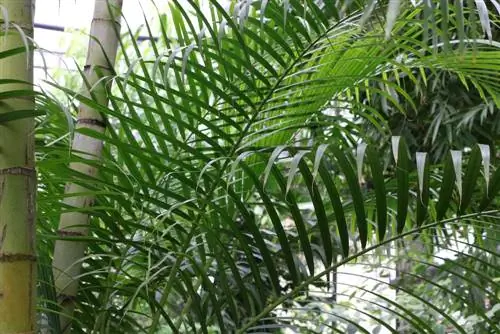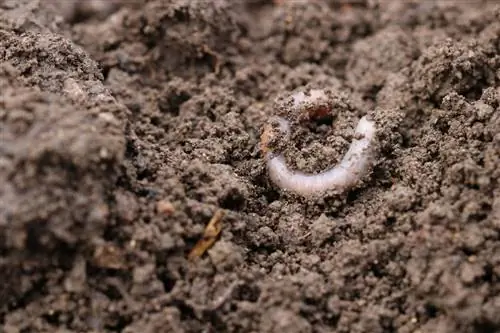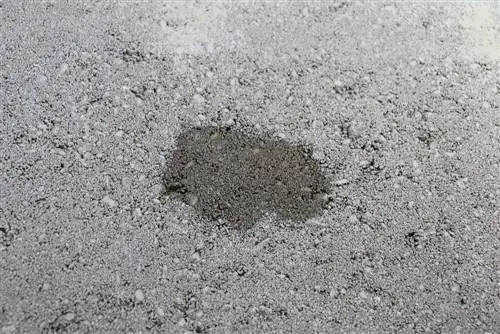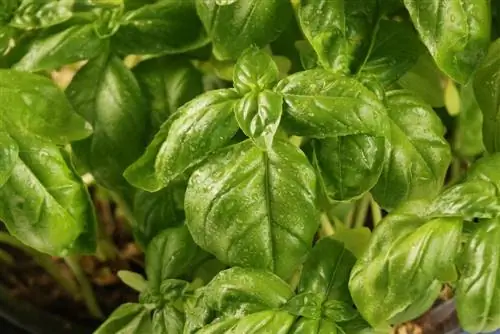- Author admin [email protected].
- Public 2023-12-17 03:39.
- Last modified 2025-01-24 12:45.
Palm trees grow in very different locations in nature. They grow in almost all warm climates, in the rainforest, in oases, by the sea or in the mountains. Their needs for sun, humidity, planting substrate and wintering are just as different. The right palm soil is given particular importance. The right substrate not only influences growth, but also the correct formation of the palm fronds and their color. In addition to commercially available mixtures, good palm soil can also be mixed yourself without much effort.
Earth from trade
Purchased palm soil usually contains garden soil and peat. Not only is peat mining harmful to the environment, but finished palm soil does not have the right combination of nutrients for palm tree growth. Ready-packed palm soil must be supplemented by adding sand, clay and perlite or expanded clay for aeration. Ready-packed peat or humus without any additives is absolutely not suitable as palm soil. The substrate collapses extremely after watering. The roots are no longer adequately ventilated. The plant dies or dies.
The right combination for palm trees
Palm trees require a slightly acidic substrate in terms of pH, with a few exceptions. A pH value of around five is particularly favorable. The soil should also be permeable, as most palm trees are more accustomed to dryness than waterlogging. In addition, the substrate should be able to store water and have the necessary nutrients. Palm trees primarily need silicates to build cells. Magnesium, iron and manganese are also important. All of these nutrients are contained in a low-phosphorus complete fertilizer, but can also be supplied via the soil through organic substances.
How does the substrate become acidic?
By adding peat, the pH value of the plant substrate slips into an acidic environment. Due to the problematic effect of peat mining on the environment, the same effect can be achieved with the peat-free supplements Coir Coconut Fiber or Cocohum.
Essential components of the planting substrate for palm trees are:
- Garden soil
- Compost, at least two years old
- Peat or coconut soil
- Perlite or clay granules for loosening
- Sand
- some coarse gravel
- clay
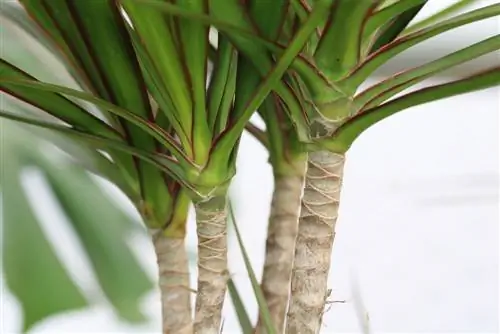
Waterlogging is, next to frost, the biggest enemy of palm trees in our latitudes. That's why you shouldn't forget a drainage layer of coarse gravel at the bottom of the pot!
The mixing ratio
Palm soil consists of two thirds garden soil and one third coarse sand or lava gravel. For palm trees that prefer a moist environment, the proportion of clay and perlite additives is increased to ensure good permeability. Palm trees that tend to thrive in dry environments get less soil in their planting substrate, but more fillers such as perlite and expanded clay. Sand or quartz grit provide important nutrients. A proportion of organic fertilizers such as guano or horn shavings is beneficial for nutrient supply.
Tip:
Around 30 percent of the proportion should be mineral.
For large palm trees, the proportion of garden soil in the planting substrate is increased so that the top-heavy palm trees have more support. Older palm trees can also only be planted in garden soil.
Recipes for palm soil mixes
Dryland palm trees
- 50 percent potting soil or coconut soil
- 20 percent drainage
- 20 percent clay or clay
- 10 percent quartz sand
Palm trees from wet areas
- 70 percent potting soil or coconut soil
- 5 percent clay or clay
- 15 percent drainage
- 10 percent quartz sand
A mixture of potting soil for palm trees
In order to germinate the seeds, in addition to a warm and humid climate, a planting substrate made of sand, peat litter (optionally coconut soil) and potting soil is sufficient.
Tip:
Once the plant has grown, it is moved into richer soil for better support.
Special requirements for the plant substrate
- Mountain palm: Loamy substrate
- Date palms: good drainage, a mixture of soil, sand and expanded clay
- Dragon tree: humus-rich soil with a high proportion of compost
- Hemp palm: very good drainage, substrate made of compost, peat, humus, sand
- Livingstonia: slightly acidic and water-permeable
- Madagascar palm: planting substrate with lots of clay
- Cycad fern: humus-rich soil
- Phoenix: a PH value of 6 from soil, sand and compost, make sure there is good drainage
- Priest palm: humus-rich soil
- Screw tree: loose, humus-rich substrate
- Cobbler palm: normal potting soil, no waterlogging
- Yucca: mineral-rich substrate with good drainage
Avoid peat if possible
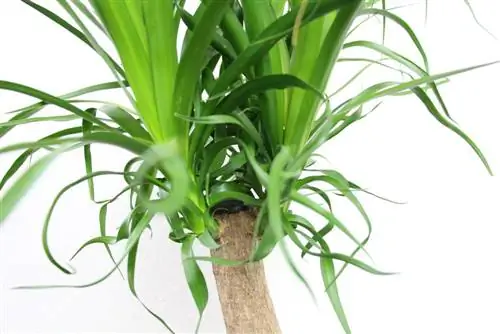
Peat stores water as a plant substrate and loosens the soil. The same result can also be achieved with peat-free soil such as coconut soil. Coconut soil consists of crushed fibers from the coconut palm. Finely chopped coconut shells, which were mixed into the coconut soil when producing the coconut soil, ensure good permeability. If coconut soil is used instead of peat in palm soil, the plant needs less watering. Coconut soil is an enormous water reservoir and can store many times its weight in water.
Repotting
Palm trees are repotted in spring. A larger planter should be chosen, especially if the roots grow out of the planting hole. The fleshy roots must not be damaged when repotting. Before the self-mixed palm soil is filled in, a drainage layer is added.
Frequently asked questions
What is the basic formula for the right palm soil mix?
Around a third of each main ingredient is used.
What are the characteristics of self-mixed palm soil?
The individual needs of different types of palm trees can be met with a homemade mixture.
Why should I make the mixture myself?
Homemade is cheaper than purchased soil.
Where can I get the ingredients for my mixture?
The individual components are available in every hardware store.
When are palm trees actually repotted?
Young plants are repotted after around six months, older plants every two to three years.

